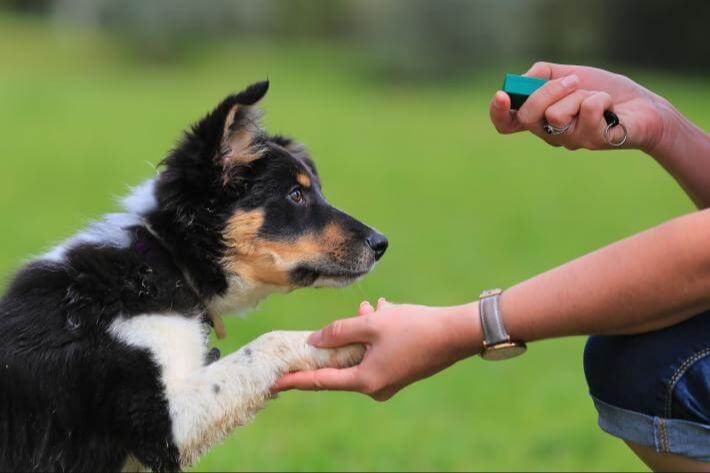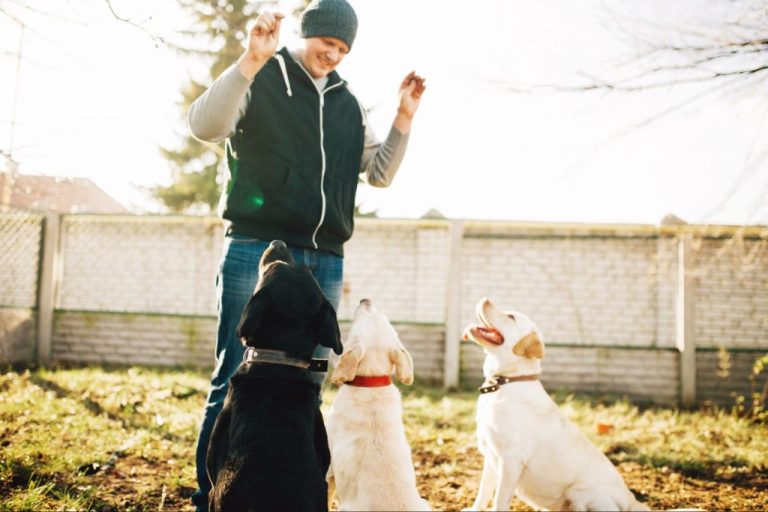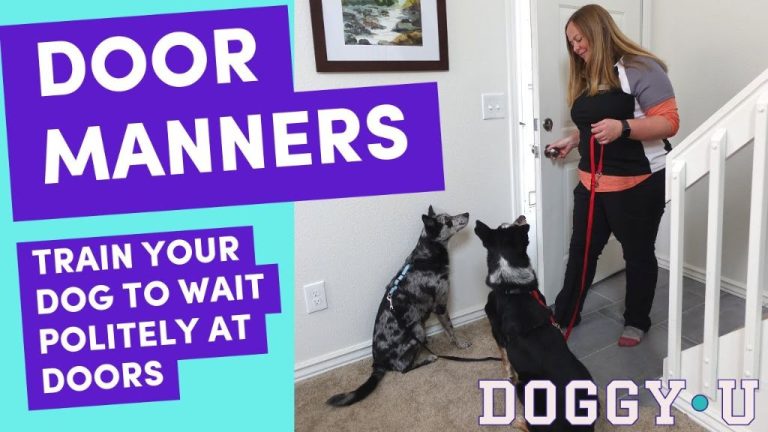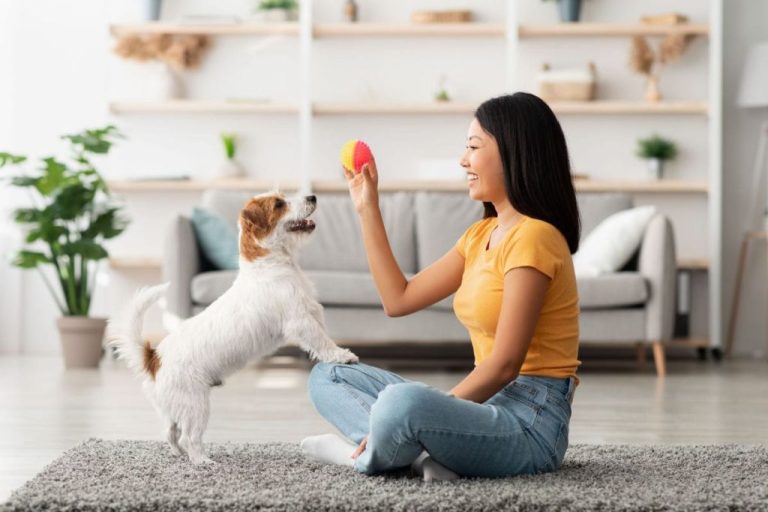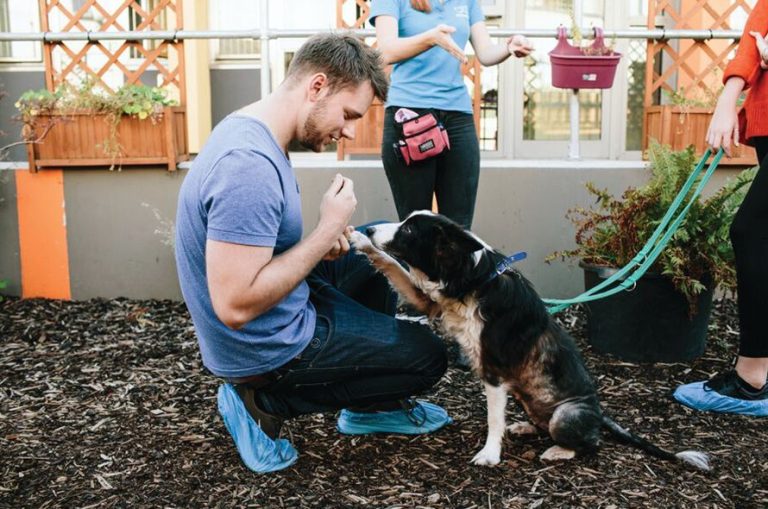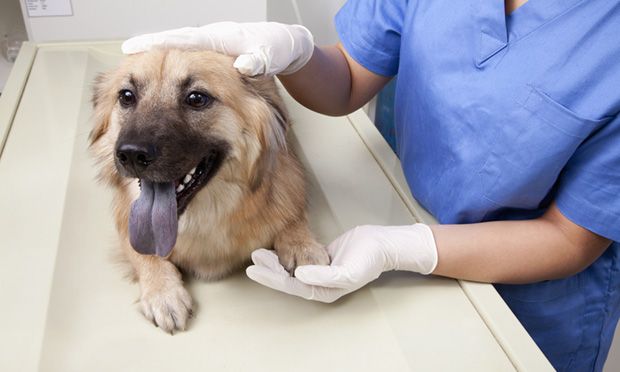Teaching Your Dog To Fetch: Step-By-Step Guide
Fetch is one of the most fun and rewarding games you can play with your dog. Not only does it provide great exercise, but it also helps strengthen the bond between you and your canine companion.
Fetch is beneficial for dogs because it provides mental stimulation and satisfies their natural instinct to chase. The game requires focus and concentration as your dog watches you throw the toy, chases after it, and then locates it to bring back. This mental exercise is key for preventing boredom and excess energy in dogs.
Fetch also provides physical exercise as your dog runs back and forth to retrieve the toy. This helps burn calories and keeps their muscles strong and fit. For high energy dogs or puppies, a good game of fetch can go a long way in preventing destructive behaviors.
Additionally, fetch helps reinforce positive behaviors through reward-based training. When your dog successfully brings the toy back, you reward them with praise, pets, or a treat. This positive reinforcement helps them learn that fetching the toy leads to good things.
With some patience and persistence, you can teach any dog to reliably play fetch. This game provides an excellent bonding opportunity while satisfying your dog’s physical and mental needs. Regular fetch sessions will keep your canine companion fit, focused, and happy.
Choose the Right Toy
When teaching your dog to fetch, it’s important to select the right toy to keep them engaged and interested in bringing it back. Here are some factors to consider when choosing a fetch toy:
Size – Make sure to pick a toy that is appropriate for your dog’s size. A toy that is too small can easily get lost or lodged in your dog’s throat. For larger dogs, choose a bigger toy that they can grab and carry easily. Chewy recommends selecting a toy about the size of your dog’s mouth.
Texture – The texture of the toy will impact how easy it is for your dog to grab and hold it. Rubber or rope toys are good choices as they have an interesting texture for dogs to grip. Avoid toys that are too smooth or slippery.
Squishiness – A soft, squishy toy often entices dogs to grab and chomp down on it. But for fetch, a firm toy that your dog can easily pick up works best. Foam or plush toys are not ideal for fetch.
Visibility – Opt for a brightly colored toy in a dark color your dog can easily spot when you throw it. Glow-in-the-dark or light-up fetch toys are also very visible for dogs.
Durability – Since fetching involves a lot of carrying, chomping, and tugging, you’ll want a toy made of tough, durable material. Hard rubber or hard plastic are good options.
Types of fetch toys like balls, flying discs, ropes, plush toys all have their own pros and cons. Consider your dog’s size, tastes, and chewing habits when selecting the right one. The key is finding a toy they really enjoy chasing after and bringing back.
Teach Your Dog to Take the Toy
The next step in teaching your dog to fetch is getting them interested in the toy and having them take it from your hand. Start by showing your dog the toy and letting them sniff and explore it. Move it around to grab their attention. Many dogs get excited just seeing their favorite toy! Once they seem interested, hold the toy in your hand and say “take it” as you present it to them. Give lots of praise and treats the first few times your dog grabs the toy from your hand. This positive reinforcement will teach them that taking the toy means good things will happen.
If your dog seems unsure about grabbing the toy, try squeaking it or waving it enticingly. You can also try smearing a small amount of peanut butter or cream cheese on the toy to encourage them to take it in their mouth. Be patient during this process – some dogs will readily take an object from your hand, while others may need more coaxing. The key is making the experience rewarding so they associate “take it” with getting treats and attention.
Continue practicing this until your dog reliably takes the toy from your hand when you give the command. Always use an upbeat, encouraging voice when saying “take it.” Once your dog has mastered taking the toy, you can move on to the next step of having them hold it.
Teach Your Dog to Hold the Toy
Once your dog reliably takes the toy, the next step is to teach them to hold onto it. Some dogs will naturally hold a toy in their mouth, while others may immediately drop it at your feet.
To teach your dog to hold the toy, start by holding it up to their mouth and giving the command “hold.” Keep holding the toy while praising them enthusiastically. Slowly let go while continuing to praise. At first, only expect them to hold it for a second or two before dropping it.
Gradually increase the time you expect them to hold the toy as they gain confidence. If they drop it too soon, say “uh uh” and repeat the process. Be patient and keep the training sessions short to avoid frustration. Use high-value treats to reward longer holds.
You can also practice hold while playing tug of war. Let them “win” the toy, then command “hold” while you hold the other end. Reward with treats and praise while they keep it in their mouth. This taps into their natural play drive.
Aim for your dog to reliably hold an object for 30 seconds or more before moving onto the next step. This teaches impulse control and is fundamental for fetch (according to this Reddit thread). Be patient and keep training sessions positive.
Throw the Toy a Short Distance
Begin by gently tossing the toy a very short distance, just a few feet, so your dog can easily get to it. The key here is to start small and set your dog up for success. Praise enthusiastically when your dog picks up and returns the toy, no matter how short the distance. Say “good fetch!” and give treats as a reward.
Make the game fun and exciting for your dog. Use an animated, happy tone of voice and body language. You want them to feel like this is a rewarding game, not a boring chore. Keep initial tosses gentle and short so your dog learns how to complete the entire sequence – run, pick up, return, drop in your hand.
Increase the distance slowly over multiple training sessions. For now, keep retrieves short, under 10 feet. Take care not to throw the toy too far or too wildly in the beginning. This early stage is all about creating positive associations.
Be very generous with praise, pets, and treats when your dog fetches the toy, no matter how short the distance. This will build their confidence and understanding of the game. Always reward the desired retrieve behavior.
Cite: https://www.akc.org/expert-advice/training/teach-your-dog-to-fetch/
Encourage Your Dog to Return
Once your dog reliably takes the toy and holds onto it, you can start encouraging them to bring it back to you. This is often the most challenging part of fetch training. Be patient, as some dogs may need more practice with this step than others.
After you throw the toy, excitedly call your dog’s name and ask them to bring it back using a phrase like “bring it here!” You can also run away from them or crouch down to help trigger their chase instinct. As soon as your dog starts returning with the toy, praise them enthusiastically and offer a high-value treat when they reach you. This reinforces that returning the toy results in something rewarding.
Try holding another treat right by your side as well to lure your dog close enough so you can take the toy. Give the treat as soon as they release the toy into your hand. For dogs that want to run off or play keep-away, two balls can be useful so you can show them the second ball before throwing the first. This convinces them that returning the ball means getting to chase the next one.
According to WagWalking, the goal is for your dog to learn that bringing the toy back each time results in praise, treats, and getting to chase it again when you throw it. With consistent rewards and practice, your dog will pick up that returning the toy is a fun part of the game.
Increase the Distance
Once your dog reliably fetches the toy from a short distance, you can gradually start to increase the distance you throw the toy. The key is to increase the distance in small increments to keep your dog successful. Going too far too fast can cause frustration. According to the AKC, you should start by only increasing the distance by a few inches at a time.
As you increase distance, make sure to continue praising and rewarding your dog when they successfully return the toy. You want to keep them motivated to run after and retrieve the toy. The Preventive Vet recommends throwing a high value treat reward as soon as your dog returns the toy to you, which will encourage them to run faster next time.
It can also help to amp up your dog’s excitement and prey drive for the toy before you throw it. Wave the toy around, squeak it, or play a quick game of tug. Then launch the toy with lots of fanfare and enthusiasm, clapping your hands and offering encouragement as your dog takes off after it. Your energy and excitement will motivate your dog to chase after the toy.
Be patient as you gradually increase the distance. If your dog seems frustrated, decrease the distance again. The goal is to challenge your dog while keeping the game fun. With consistent practice, your dog will happily run farther distances to play fetch.
Practice Every Day
Daily repetition is important for properly training the fetch command. Once your dog understands the basics of fetching, aim to practice for a few minutes every day to reinforce the behavior. Keep each training session short and positive – about 5 to 10 throws max. Try to end on a good note with a successful fetch so your dog is excited to play again the next day.
Practicing fetch regularly helps establish it as a fun routine for you and your dog while preventing them from getting bored or frustrated. According to dog experts, frequent short sessions are more effective for training than occasional long sessions which can tire out both you and your dog. Just a few minutes a day is enough to maintain an enjoyable game of fetch.
Troubleshooting Common Issues
Some common issues that may arise when teaching your dog to fetch include losing interest, chewing the toy, and not releasing the toy. Here are some tips for troubleshooting:
If your dog loses interest in fetching, try switching up the toys you use or location of play. You can also try revving up your dog’s prey drive by waving the toy around and using an excited voice before throwing it. Shortening the fetching sessions may help keep your dog engaged. Consider whether something like joint pain is making fetching unappealing (Source).
If your dog tends to chew or rip apart fetch toys, try more durable rubber or rope toys. You can also teach “Give” or “Drop it” commands to prevent destructive chewing. Redirect chewing by providing appropriate chew toys after fetch sessions.
To stop your dog from running off with the toy, practice the “Give” command at close distances first. Always reward with treats and praise when your dog releases the toy to you. If needed, have a second toy ready to entice your dog to drop the first. Avoid chasing your dog, which can reinforce the behavior.
Patience and consistency are key in troubleshooting fetch training issues. Keep sessions short and engaging to hold your dog’s interest. With time and positive reinforcement, you can redirect unwanted habits.
Next Steps After Mastering Fetch
Once your dog consistently fetches and returns the toy at home, you can start trying new locations outside the home to challenge your dog. Try playing fetch at the park, beach, or other open areas without many distractions at first. Then gradually move to busier locations as your dog masters the skill.
You can also start teaching more advanced fetch skills like having your dog fetch multiple toys before returning or catching objects like frisbees or balls mid-air. Start by throwing 2 toys in quick succession and asking your dog to “fetch.” Praise enthusiastically when they retrieve both toys. For catching, initially toss an easy-to-catch soft toy and work up to tossing tennis balls for them to catch.
Take things slowly, keep training sessions short and fun, and use high-value treats to reward successful catches. With patience and consistency, your dog can progress to impressive fetch skills!

